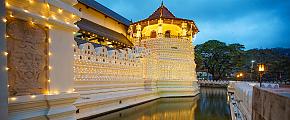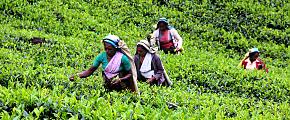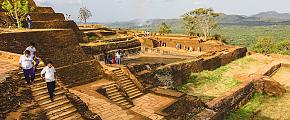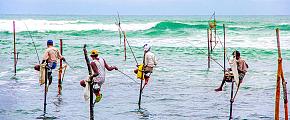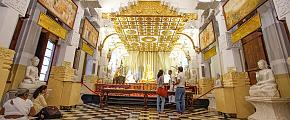Walk and Talk in Sri Lanka: Meeting the Locals
"As simple as the stories are, these were experiences that stay freshest in my memory from my Sri Lanka trip. Of course, my visits to the beaches and other attractions were all amazing, but these small moments definitely gave my adventure much more meaning. I was that close to locals and their life!"
– Mavis Jiang, Travel Consultant at Odynovo Tours
Fish Market Tour in Negombo
Once a fishing village, Negombo has seen a tourism boom in recent years, thanks to its proximity to the international airport of Sri Lanka and the Indian Ocean. One of the best ways to get a glimpse of local life is to walk into its markets. So we could not visit Negombo without seeing its fish market. There are two fish markets there: one in the town center and another near the Lagoon Bridge (some 13 kilometers away from the town center). The second fish market is bigger with more open areas. If you can make an early start around 6 am, you will be able to witness the spectacle of fishing boats returning with the day's catch. Considering we arrived there at midnight and woke up at 8 am, it would be too late to see the big fish market, we made our way to the small one in the town center.
"Even the first timers to Negombo can easily find the fishing markets through their noses" I read this in a book and found it no exaggeration. The smell of sun-baked fish hit our faces the second we opened the car door. Mixed with the humid air we could taste it like a sauce in our mouths. In front of us, on the open beach, heaps of fish were drying out in the sun. Some fishermen were packing the dried ones for sale. It was a unique experience to walk through the areas.
As we approached the shore, a bustling scene jumped into our eyes: fishermen were selecting fish out of nets; some were sorting and cleaning them; upon the glittering sea, a few small fishing boats were floating back after a fishing trip; quite a few sea birds were flying in the sky, occasionally scrambling for tasty treats. Under the blazing sun, the fishermen were dripping in sweat. As you can imagine, life is so hard for them, particularly considering this is a daily occurrence.
A stroll down the beach took us to the selling area of the market. Here, all varieties of fish were laid out for sale. Buyers went around, looking for the freshest seafood, mostly with a small bucket or black plastic bag in their hands. We also came across some Westerners who were haggling over crabs in English. Our private guide told us that the crabs from the Negombo Lagoon are both big and tasty. If there is plenty of time, it would be nice to purchase some and ask a nearby restaurant to cook for you.
There were also a few stalls selling vegetables and fruits in the market. My attention was grabbed by a jackfruit stall. And as is told by our guide, freshly minced jackfruits mixed with curry and onion is a very famous dish in Sri Lanka. No wonder it was so busy.
I've heard about a kind of cheap and healthy drink in Sri Lanka - the sweet king coconut water, but I never expected to see it right outside the fishing market! It costs 50 rupees for one. No sooner than I paid, the vendor smartly cut it for me. And I drank it up at almost one breath. The juice was yummy and especially thirst-quenching. The vendor pointed to the husk in my hands and motioned me to give him, and I was wondering why. The next moment, I saw he cut the husk and magically returned me with a coconut 'spoon'. Wow, there was tender, slippery coconut pulp to eat, and it tasted like jelly!
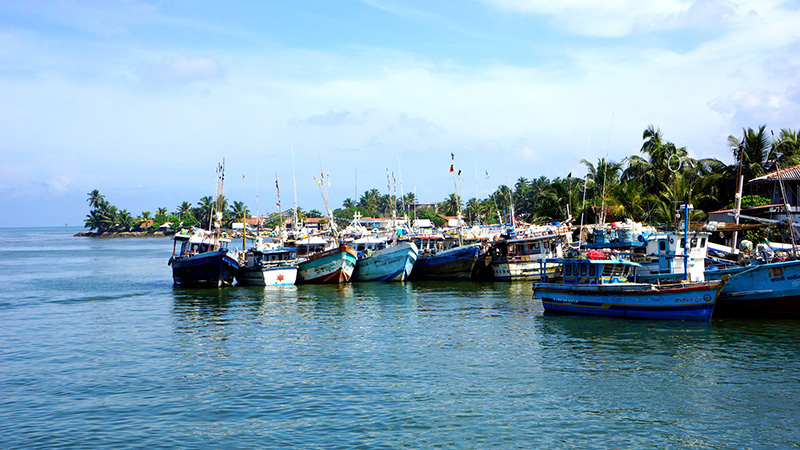 Fish Market in Negombo
Fish Market in Negombo
Lotus Blooming in Heart, in Anuradhapura
It may still stay with you, that the government of Sri Lanka declared a ceasefire with the Liberation Tigers of Tamil Eelam (LTTE); however, the warm monsoon from the Indian Ocean has slowly healed the country from the wounds of war. It is just like the lotus, the national flower, excluding fragrance quietly, neither humble nor pushy.
In this serene corner of the world, the sacred city of Anuradhapura intrigues me the most. It is the oldest city in Sri Lanka, with a history of 2,500 years. It first became the capital of Sri Lanka in 380 BC; in the following one thousand years, it had been the seat of political power and the Buddhist center. For Buddhists, getting to this sacred city is regarded as a once-in-a-lifetime trip. Pilgrims of all ages were dressed in white. White signifies a pure heart to Buddha. Lotus replaced joss sticks to represent their best wishes.
We arrived in Anuradhapura after heavy rain, which I predicted from the remaining water on the street. According to local custom, shoes should be removed before entering temples and yards of stupas. Everyone is expected to follow it, including the royalty. So, I was barefoot on the wet ground of the Sri Mahabodhi Temple. To be honest, I was quite uncomfortable with that. But as I was immersed in the religious atmosphere all around me, the discomfort seemingly faded away. It was like, all of the human senses were weakened, and a voice within you was telling you to calm down. You might have been working for days or disturbed by household affairs, but at that moment, you can put down everything, just close your eyes, and feel the solitude, your mind is in a state of peace, a state which you can hardly reach in the modern society. It became no longer important whether you are a Buddhist or not.
From a distance, I saw a big tree. Beneath it were people. Lots of people. It's the famous Sri Mahabodhi Tree, the world's oldest historically documented tree. It is not only the centre of Anuradhapura but also the national treasure only second to the Buddha tooth in Kandy. More than 2000 years ago, when Princess Sanghamitta, the daughter of Ashoka, Sangha, came to Sri Lanka to preach Buddhism, she brought a branch of the tree under which Sakyamuni attained enlightenment Nirvana after 7 days of meditation. Over the years, the branch has grown into what we see today, a luxuriant banyan tree. It is also said that the famous Bodhi tree in India's Bodh Gaya, was in fact transplanted from this one. If you had been to Bodh Gaya before coming to Anuradhapura, how amazing is that, seeing the same tree in two different spaces?
Leaving the Bodhi tree behind us, we came to the ruins of Mahasen Palace. An elaborately carved semi-circular stone lies at the bottom of the steps leading to an intact, sitting Buddha. It is called 'Moonstone'. The outmost band of it contains a carving of flames, symbolizing worldly desires. It is followed by carvings of four animals: elephants, lions, horses, and bulls. These four animals following each other in a procession symbolize the four stages in life: birth, decay, disease, and death. The third band has carvings of a half lotus with an intricate foliage design. Swans, symbolizing the distinction between good and bad, are carved on the fourth band. On the center of the moonstone is the half lotus with a clear design, which signifies the final achievement of Nirvana. If we can reduce our desires and keep our minds simple, we can be free from worries and thus attain Nirvana - that is the ultimate meaning of the half lotus. At that moment, I wondered. What if life became less about what we don’t have and more about what we already have? We cannot become Buddha, but with fewer desires, we can live life more happily.
In a sacred Buddhist place, there must be stupas. In Anuradhapura, stupas are called "dagobas". Most of the dagobas are placed on circular foundations and have a cone-shaped dome. It is said that the domes of dagobas were built to resemble fields to symbolize harvest. According to our guide, there are many dagobas in Anuradhapura, and three of them are not to be missed: the Ruvanvelisaya Dagoba, the Thuparama Dagoba, and the Jetavanarama Dagoba.
The first stupa we came to visit was the Ruvanvelisaya Dagoba, the most beautiful one in Anuradhapura. It is all white and highly revered for the relics enshrined in it. A sea of pilgrims surged towards the stupa. I looked around and discarded the idea of walking around it.
The most valuable stupa, the Thuparama Dagoba, was being restored, so we only had a look from the outside. It was built to enshrine Buddha's collarbone. Several pillars surrounding it form 2-4 circulars and are topped with carvings of lotus, swan, lion, etc.
The Jetavanarama Dagoba. It struck me at first sight. The entire structure was built of brown red bricks. With a height of 70 meters and a diameter of 110 meters in its base, it is the largest stupa in Sri Lanka, and one of the biggest in the world. Its top is weathered, while the color has a sense of history. The colossal structure looks majestic and mysterious. It reminds me of the Egyptian pyramids. If I remember right, its history can be traced back to 3rd century BC. With few others in sight and the cool breeze. I took the chance to walk around the stupa. How long does it take to walk around it? I made the bet with my tour guide. And I lost. It took me 10 minutes to finish the walk, including a few seconds admiring the exquisite Buddha statues in the temple on the back of the dagoba. "But it’s understandable." I consoled myself. After all, who can know the answer better than a Buddhist who has prayed countless times here and encountered many curious tourists like me?
As dusk began to settle in, our car slowly drove out of the sacred city. The stupas were scattered in the forest, and the ruins and stones stood there silently. It suddenly occurred to me that, in the noisy world, it is so precious to have a city that can easily calm you down. In the following days, I climbed up to the majestic Lion’s Rock, visited the second ancient city of Polonnaruwa, relaxed under the starry sky of the Pasikuda beach and strolled the Trincomalee beach, but whenever things quieted down, I couldn't help thinking of Anuradhapura, the moonstone and the stupas.
It seemed that, this tour had sowed a lotus seed in me, and it was blooming to nourish and support me to become a simple person.
A Memorable Home Visit
With the thought that "A trip would not be complete without personally seeing the real life of locals", we made a stop at a local home when passing through the countryside of Sigiriya. Assured of our good intentions, the hostess agreed with us to visit her home. We were led into her courtyard. "Nangi," our tour guide called her warmly. At first, we mistook it as her name. But it actually means "sister" in Sinhalese. Having known her age, we began to call her "Nangi". She is but 21 years old, yet is already a mother of twins aged one and a half. Now her third baby is on the way. Her husband went out to do farm work that day so her sister came to help take care of the kids.
With bushy eyebrows and huge eyes, the little ones looked so adorable that I put up my camera involuntarily. The younger one gazed upon us, with his big eyes conveying curiosity, while his brother burst into tears all of a sudden. I had no clue why he was crying. Oddly, when I put it away, he stopped crying. Not until I noticed the only photograph in the house was a wedding photo, did I realize that he might be scared of the black "boxes". The kids might have never seen a camera before.
It was a mud house that the whole family lived in, a traditional one in Sri Lanka. The floor was paved with cow dung and mud, which is surprisingly insulated and watertight. The wall was dubbed with very solid clay. "Nangi" told us the old house was a gift from her parents, who built a new one in the vicinity. We walked into her bedroom and couldn't believe the simplicity: there was only a bed, a mosquito net, a wooden bench covered with sheets and pillows, and clothes put in order on a wooden pole. The scene was poignant for all of us. However, that feeling didn't last long. "Nangi" then showed us around her kitchen and garden - both were clean and tidy. She is a capable housewife. Her smiles and soft words made us know that she still holds a passion for life and hope for the future even in the midst of poverty, which kept us at ease.
We wished to stay longer with "Nangi", but it was time to move on. We searched in our bags for some gift items for the kids, only to find two boxes of biscuits. So we took out a few rupees. At that moment we all felt ashamed. Giving out money seems unfitting when confronted by such pure souls. But with no preparation made beforehand, we had no other choice. "Please ask her to take the money. It's just a token of our regards, we wish she could have a happy life and the kids grow up healthily" we requested the guide. A photograph of "Nangi" and her family was left on my camera. Now it is my desktop wallpaper, reminding me to cherish what I have.
